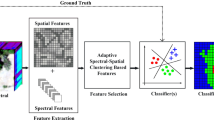Abstract
Hyperspectral band selection aims at the determination of an optimal subset of spectral bands for dimensionality reduction without loss of discriminability. Many conventional band selection approaches depend on the concept of “statistical distance” measure between the probability distributions characterizing sample classes. However, the maximization of separability does not necessarily guarantee that a classification process results in the best classification accuracies. This paper presents a multidimensional local spatial autocorrelation (MLSA) measure that quantifies the spatial autocorrelation of the hyperspectral image data. Based on the proposed spatial measure, a collaborative band selection strategy is developed that combines both spectral separability measure and spatial homogeneity measure for hyperspectral band selection without losing the spectral details useful in classification processes. The selected band subset by the proposed method shows both larger separability between classes and stronger spatial similarity within class. Case studies in biomedical and remote sensing applications demonstrate that the MLSA-based band selection approach improves object classification accuracies in hyperspectral imaging compared with conventional approaches.
Similar content being viewed by others
References
Anselin L (1995) Local indicators of spatial association—LISA. Geogr Anal 27:93–115
Beigi M, Chang S, Ebadollahi S, Verma D (2009) Multi-scale temporal segmentation and outlier detection in sensor networks. IEEE International Conference on Multimedia and Expo, pp. 306–309
Bruzzone L, Roli F, Serpico S (1995) An extension of the Jeffreys-Matusita distance to multiclass cases for feature selection. IEEE Trans Geosci Remote Sens 33:1318–1321
Cliff A, Ord J (1981) Spatial Processes, Models and Applications. Pion, London
Du Z, Jeong M, Kong S (2007) Band selection of hyperspectral images for automatic detection of poultry skin tumors. IEEE Trans. Autom. Sci. Eng. 4(3):332–339
Getis A, Ord J (1992) The analysis of spatial association by use of distance statistics. Geogr Anal 24:189–206
Huang R, He M (2005) Band selection based on feature weighting for classification of hyperspectral data. IEEE Geosci Remote Sens Lett 2:156–159
Jensen J (1996) Introductory digital image processing: a remote sensing perspective. Prentice-Hall, Englewood Cliffs
Jeong Y, Kim S, Jeong M (2008) Automatic identification of defect patterns in semiconductor wafer maps using spatial correlogram and dynamic time warping. IEEE Trans Semicond Manuf 21(4):625–637
Kong S, Chen Y, Kim I, Kim M (2004) Analysis of hyperspectral fluorescence images for poultry skin tumor inspection. Appl Opt 43(4):824–833
Kononenko I (1994) Estimating attributes: analysis and extensions of RELIEF. In: Proceedings of seventh european conference on machine learning, pp 171–182
Kopisch M (1995) Spatial relations in technical domains. Appl Intell 5(4):351–366
Landgrebe D (2002) Hyperspectral image data analysis as a high dimensional signal processing problem. IEEE Signal Process Mag 19(1):17–28
Liu D, Setiono R (1998) Incremental feature selection. Appl Intell 9(3):217–230
Milenova B, Campos M (2005) Mining high-dimensional data for information fusion: a database-centric approach. In: Proceedings of 8th international conference on information fusion, vol 1, pp 7–14
Park J, Jeong M (2010) Recursive support vector censored regression for monitoring product quality based on degradation profiles. in press. Applied Intelligence
Schott J (2005) Matrix analysis for statistics, 2nd edn. Wiley, New Jersey
Serpico S, Moser G (2007) Extraction of spectral channels from hyperspectral images for classification purposes. IEEE Trans Geosci Remote Sens 45(2):484–495
Simin C, Rongqun Z, Wenling C, Hui Y (2009) Band selection of hyperspectral image based on Bhattacharyya distance. WSEAS Trans Inf Sci Appl 6(7):1165–1175
Stein A, van der Meer F, Gorte B (1999) Spatial statistics for remote sensing. Kluwer Academic, Dordrecht
Swain P, King R (1973) Two effective feature selection criteria for multispectral remote sensing. In: Proceedings of the first international joint conference on pattern recognition, pp 536–540
Tu T, Chen C, Wu J, Chang C (1998) A fast two-stage classification method for high-dimensional remote sensing data. IEEE Trans Geosci Remote Sens 36:182–191
Withagen P, Breejen F, Franken F, De Jong A, Winkel H (2001) Band selection from a hyperspectral data-cube for a real-time multispectral 3CCD camera. In: Proceedings of SPIE conference on algorithms for multispectral, hyperspectral, and ultraspectral imagery VII, vol 4381, pp 84–93
Author information
Authors and Affiliations
Corresponding author
Rights and permissions
About this article
Cite this article
Du, Z., Jeong, YS., Jeong, M.K. et al. Multidimensional local spatial autocorrelation measure for integrating spatial and spectral information in hyperspectral image band selection. Appl Intell 36, 542–552 (2012). https://doi.org/10.1007/s10489-010-0274-8
Published:
Issue Date:
DOI: https://doi.org/10.1007/s10489-010-0274-8




